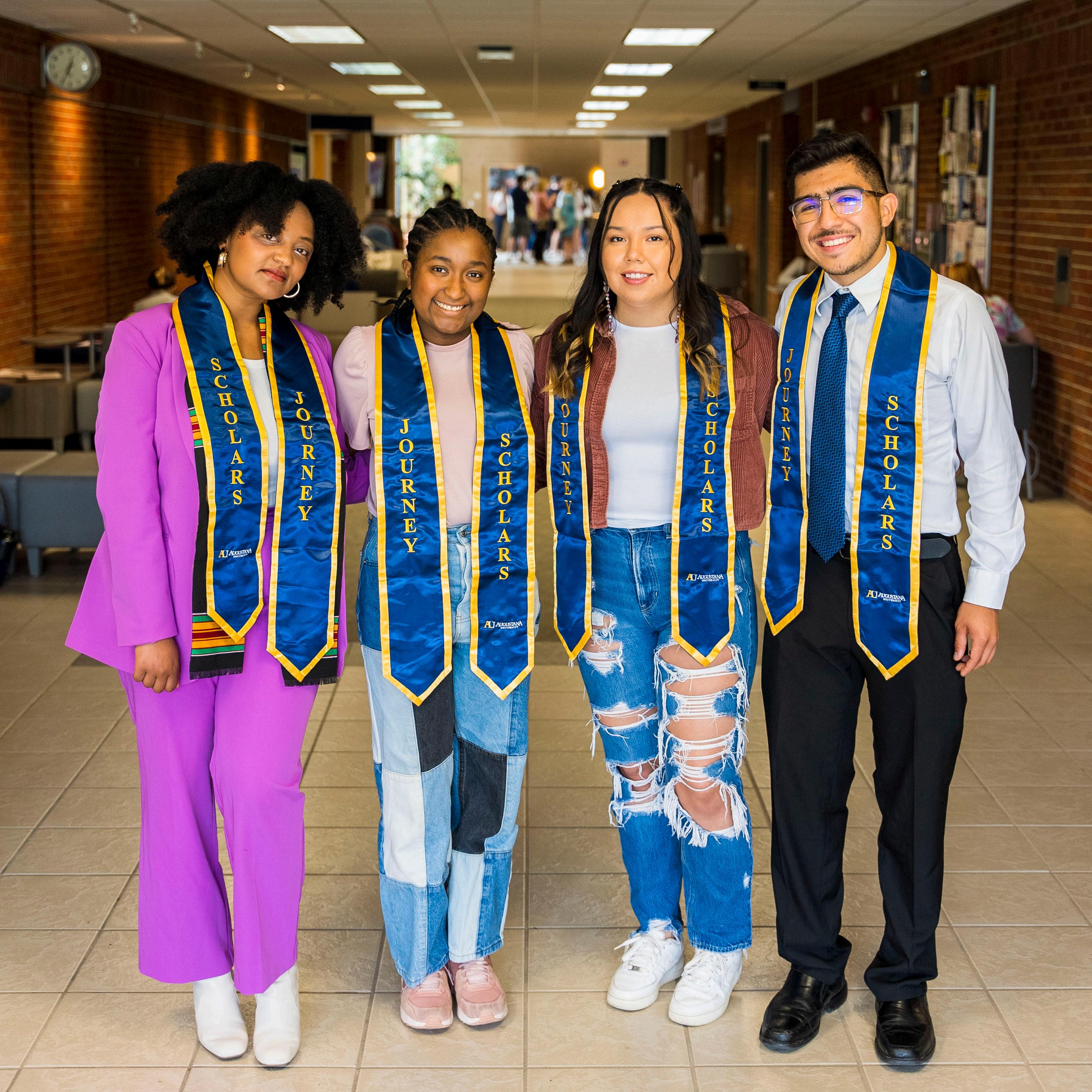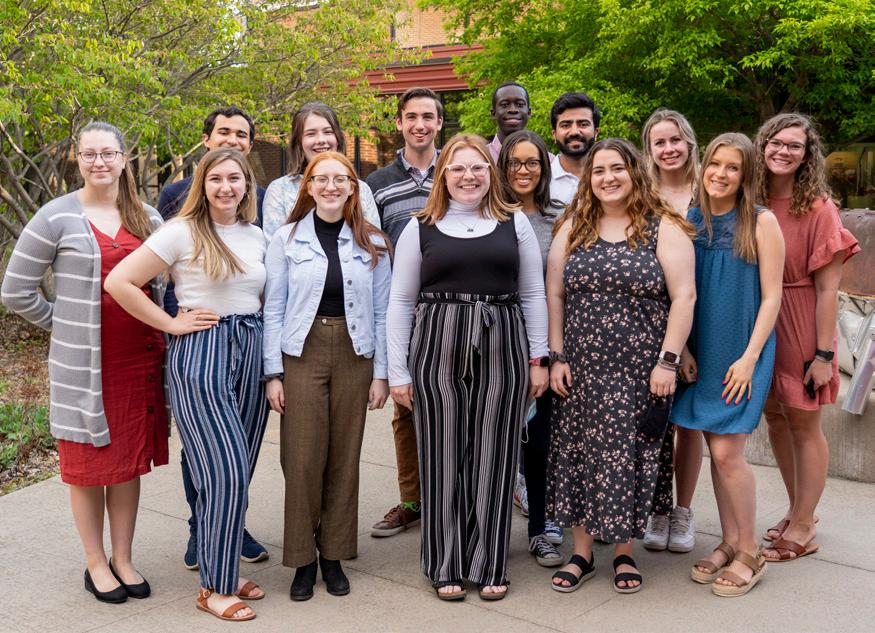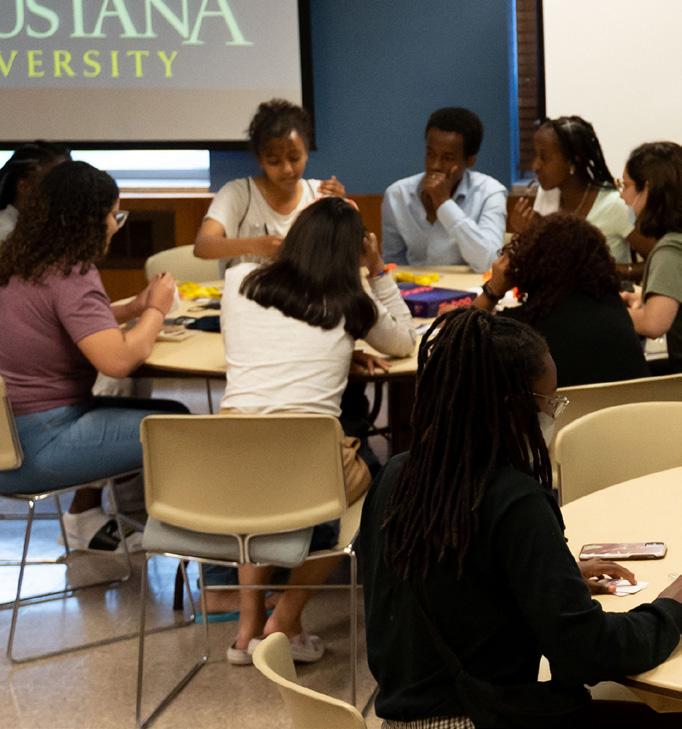OUR CORE VALUES DEFINE OUR CONTEXT FOR DIVERSITY
Central to the Augustana experience are five core values. The community lives them and honors them, and they infuse the academic curriculum as well as student life. These five values are identified below, followed by a phrase that sums up the essence of the word as it informs the university’s mission. These phrases are, in turn, followed by how the value is expressed in the daily life of the university and its people.
CHRISTIAN - “By being a university of the Evangelical Lutheran Church in America”
• Centering on worship
• Welcoming all faiths
• Nurturing the search for a mature religious faith
• Relating Christian faith and ethics to learning and service
Diversit y is central to our Christian values, as Jesus taught and ministered to those different from him and showed us in his parables that scorning those who are different defies and denies the Kingdom of God.
LIBERAL ARTS - “By providing an education of enduring worth”
• Affirming teaching and learning as central and lifelong
• Fostering a broad understanding of humans and their interactions
• Enriching lives by exposure to enduring forms of aesthetic and creative expressions
• Developing broad knowledge and skills crucial in a changing world
• Creating awareness of one’s own religious and ethical beliefs and those of others
• Cultivating health and wellness
Augustana’s liberal arts curriculum embodies diversity on an academic level as it brings students into contact with different kinds of knowledge and different ways of learning.



2



EXCELLENCE - “By committing to high standards and integrity”
• Practicing faithfulness in teaching, learning, supporting, administering
• Nurturing potential
• Challenging the intellect
• Acting ethically
• Recognizing achievement
Our value of excellence is enhanced by diversity, as different experiences and different ways of thinking encounter each other and work together to bring us forward into the new experience and new ways of thinking.
COMMUNITY - “By caring for one another and our environments”
• Responding to needs
• Respecting human differences
• Empowering one another
• Tending to the ecology of place
Communit y cannot truly exist without diversity. The Latin term adopted as our nation’s motto, “E Pluribus Unum” or “From many, one,” speaks directly of the plurality needed to create a lasting unity.
SERVICE - “By affirming that wholeness includes reaching out to others”
• Accepting the call to servanthood
• Promoting justice
• Integrating career and service
• Serving church and society
Service is truly service when it is enacted on behalf of others in a diverse world. Addressing the circumstances in which people who differ from us live and serving them there takes us beyond ourselves and makes our service meaningful
3

The four key areas that summarize the ethos of Augustana’s Diversity, Equity & Inclusion Plan, which is intended to reshape, refine and guide members of the campus community on how to invest in diversity, equity and inclusion, are as follows:
• Establish the underpinnings to develop a more diverse culture at Augustana
• Increase the recruitment of underserved populations within each campus community constituency — leadership, employees and students
• Ensure that students graduate with the habits of mind needed to be effective members of a diverse community
• Establish financial support and institutional accountability

4




DIVERSITY DEFINED
Augustana is committed to providing equal access to and participation in employment opportunities and in programs and services, without regard to race, color, religion, creed, sex, pregnancy, sexual orientation, gender, gender identity, genetic information, national origin, ancestry, age, veteran status or disability. Augustana complies with Title IX of the Education Amendments of 1972, Title VII of the Civil Rights Act, the Americans with Disabilities Act, the Rehabilitation Act and other applicable laws providing for nondiscrimination against all individuals. Augustana will provide reasonable accommodations for known disabilities to the extent required by law.
5
UNIVERSITY GOALS
1.
Develop and maintain a campus culture in which diversity is valued and all members of the campus community feel welcomed, supported and included and are actively engaged.
a. Assess optimal organizational structure and resources to support diversity and inclusion programming and initiatives.
b. Conduct inter-cultural competency and sensitivity training that develops core diversity awareness for all campus community constituencies—faculty, administrators, coaches, suppor t staff and students.
c. Encourage, support and recognize individual and group contributions to creating and sustaining dialogue on and ser vice to issues of diversity and inclusion through curricular and co-curricular activities, such as . . .
i. Pedagogy, programming, projects, research, leadership development
ii. Foster cultural living/learning communities across campus
d. Integrate and highlight Augustana’s commitment to diversity and inclusion in communications and marketing materials, university events, development initiatives and alumni outreach and programming.


6
2.
Increase diversity within each campus community constituency.
a. Students
i. Assess current practices related to recruiting, enrolling and retaining a diverse student body—undergraduate and graduate
1. Determine which strategies have been most effective over the past 5 years.
2. Review adequacy of financial aid resources necessary to support a more diverse student body.
3.. Determine which groups of underrepresented populations Augustana is currently best prepared to serve.
ii. Sur vey current and prospective students who are from underrepresented groups in order to identify influencers affecting enrollment (and retention), such as . . .
1. Relatable degree programs and majors that are popular among underrepresented student populations.
2. Transition support, including summer bridging, online modules, host families and special orientation courses.
3. Financial aid resources.
iii. Develop an admissions and communications strategy specific to local high schools and those in target markets, urban or rural, with high concentrations of diverse students, and leverage established relationships of those in the campus community with such schools.
iv. Develop and support a targeted strategy for international student recruitment.
v. Increase opportunities for K-12 students to participate in Augustana programs that strengthen their candidacy for enrollment, such as . . .
1. Summer course offerings
2. Pre-collegiate academies
3. Faculty-guided research
4. Auditing classes
7
b. Faculty
i. Assess the diversity of each academic department, compile information on faculty demographics, retention and promotion, and identify positions that may come open within the next two years due to growth, attrition, etc.
ii. Define institutional standards to be used by search committees that will emphasize diversity as a consideration and conduct intercultural competency and sensitivity training for search committee members.
iii. Implement best practices for increasing the probability of a diverse candidate pool, such as . . .
1. Faculty attendance at conferences to meet and recruit potential hires.
2. Building relationships with educational institutions that graduate Ph.D.’s from historically underrepresented populations in higher education.
3. Collaborating with other educational institutions and other employers within Sioux Falls and surrounding communities to explore partnerships that emphasize diversity in hiring.
iv. Evaluate and improve practices that support the success and retention of a diverse faculty, such as . . .
1. Orientation and mentoring programs
2. Resources to support internal and external affinity groups (groups linked by a common purpose, ideology or interest that host meaningful events, engage in mentoring and foster community among underrepresented and diverse populations)
3. Sur vey faculty from under-represented groups to obtain information on decisions to remain at Augustana.
v. Examine the feasibility of creating unique programs to attract faculty from diverse backgrounds, such as . . .
1. Visiting scholars
2. Teaching fellowships for doctoral candidates of color/underrepresented populations
3. Faculty exchanges
8
c. Administrators, Coaches and Support Staff
i. Assess the diversity of each department, compile information on employee demographics, retention and promotion, and identify positions that may come open within the next two years due to growth, attrition, etc.
i. Define institutional standards to be used by search committees that will emphasize diversity as a consideration and conduct intercultural competency and sensitivity training for search committee members.
iii. Implement best practices for increasing the probability of a diverse candidate pool, such as . . .
1. Collaborating with other educational institutions, health systems and other employers within Sioux Falls and surrounding communities to explore partnerships that emphasize diversity in hiring.
iv. Evaluate and improve practices that support the success and retention of diverse administrators, coaches and support staff, such as . . .
1. Orientation, mentoring programs and continuing education opportunities
2. Resources to support internal and external affinity groups (groups linked by a common purpose, ideology or interest that host meaningful events, engage in mentoring and foster community among underrepresented and diverse populations)
3. Survey staff from underrepresented groups to obtain information on decisions to remain at Augustana.
v. Track employee turnover and include questions in exit interviews that pertain to diversity and inclusion/campus climate in order to identify the successes and barriers for specific demographic groups.



9
3.
Enhance students’ understanding of diversity-related engagement, educational opportunities and cultural experiences to ensure that future graduates of Augustana possess the knowledge, skills and habits of mind necessary for living and working effectively as members of a diverse, global society.
a. Integrate diversity education and experiences more deliberately into the curriculum, star ting with FYS courses and including advanced courses (ideally as part of each major, but particularly for pre-professional programs in business, nursing and education).
i. Facilitate professional development opportunities for faculty related to effective integration of diversity education (e.g., inclusive pedagogy, mentoring, advising).
ii. Develop and enhance relationships with the local community to expand meaningful diversity experiences and/or cultural exchange programs that connect to coursework.
iii. Include more courses that expand the diversity of ideas and perspectives within disciplines and that are likely to attract more diverse faculty and students.
iv. Explore new majors, minors and academic programs (e.g., social justice) that have a more direct focus on diversity and that create different career and service pathways for students.
b. Integrate diversity education and experiences more deliberately into experiential learning opportunities.
i. Emphasize deep learning experiences via reflection, immersion and ser vice for study abroad and local off-campus study.
ii. Cultivate more internal collaborative relationships around international education, global learning and diversity education.


10
c. Integrate diversity education and experiences in a more deliberate manner into co-curricular programming, starting with Welcome Week activities for first year students.
d. Develop criteria for evaluating and assessing student learning outcomes and engagement related to diversity education.
i. Track progress by academic department.
ii. Develop an inventory of diversity-focused student learning opportunities inside and outside the classroom.
e. Cultivate an environment in which students of diverse backgrounds can thrive academically and professionally.
i. Collect and analyze data about learning outcomes, student success and career pathways (e.g., retention and graduation rates, GPA, coursetaking patterns and career placement)
ii. Collaborate with the Student Success Center to build on the existing (or establish a new) mentoring program that partners with local schools, organizations and/or professional associations that serve diverse constituencies in order to create mutually beneficial educational experiences.
iii. Review and revise (as needed) tutoring policy and program to ensure students of diverse backgrounds have access and feel welcomed/supported.
iv. Identify, assess and enhance (as needed) existing programs aimed at retention, suppor t and success for students from groups that have been historically underrepresented at Augustana.
11
4.
Establish institutional accountability measures and enhance the support infrastructure around diversity policies, practices and initiatives to reflect the institutional commitment to diversity.
a. Review institutional policies and practices to ensure a focus on diversity, inclusivity, equity and compliance.
i. Review and revise (as needed) all policies to ensure that language is reflective of the breadth of the diversity definition.
ii. Identify those programs, policies and practices that may inadvertently create barriers to academic progress and achievement for historically underrepresented students and develop strategies for transforming such practices (e.g., enhancing academic advising systems).
iii. Enhance the weight of diversity-related work in employee processes (e.g., recruitment initiatives, tenure process and merit).
b. Review and revise (as needed) organizational structures and committees to ensure effective implementation of diversity goals.
i. Explore the benefits, cost and infrastructure for the Office of Diversity, Equity & Inclusion and its leadership.
ii. Clarify the role of the Diversity Advisory Committee and establish diversity advisor y teams.
iii. Seek diverse representation on university councils, committees and task forces, including advisor y bodies such as alumni, parents, etc.
iv. Include a focus on diversity when building and strengthening university par tnerships—alumni, business, community and government—to enhance diversity initiatives.
v. Establish a strategic response team and response plans for bias-related incidents.
12
c. Identify appropriate assessment measures and goals, and monitor progress toward goals.
i. Evaluate national student survey results, enrollment demographics, retention data, GPA at graduation, graduation rates, etc.
ii. Develop database of diversity-related efforts/work by division, department, program or office.
iii. Support student, staff and faculty-led diversity research on campus, including research that specifically addresses AU’s institutional data.
iv. Assess faculty/staff/student/alumni perceptions of commitment to diversity.
d. Other support
i. Create a diversity fund to encourage and support innovation related to diversity initiatives.
ii. Designate physical spaces across campus, including a multicultural center, for activities and dialogue focused on diversity, inclusion and equity issues.

13
OFFICE OF DIVERSIT Y, EQUIT Y & INCLUSION




























